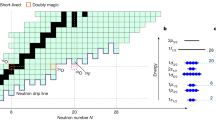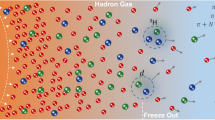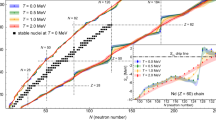Abstract
The dominant decay mode of atomic nuclei is beta decay (β-decay), a process that changes a neutron into a proton (and vice versa). This decay offers a window to physics beyond the standard model, and is at the heart of microphysical processes in stellar explosions and element synthesis in the Universe1,2,3. However, observed β-decay rates in nuclei have been found to be systematically smaller than for free neutrons: this 50-year-old puzzle about the apparent quenching of the fundamental coupling constant by a factor of about 0.75 (ref. 4) is without a first-principles theoretical explanation. Here, we demonstrate that this quenching arises to a large extent from the coupling of the weak force to two nucleons as well as from strong correlations in the nucleus. We present state-of-the-art computations of β-decays from light- and medium-mass nuclei to 100Sn by combining effective field theories of the strong and weak forces5 with powerful quantum many-body techniques6,7,8. Our results are consistent with experimental data and have implications for heavy element synthesis in neutron star mergers9,10,11 and predictions for the neutrino-less double-β-decay3, where an analogous quenching puzzle is a source of uncertainty in extracting the neutrino mass scale12.
This is a preview of subscription content, access via your institution
Access options
Access Nature and 54 other Nature Portfolio journals
Get Nature+, our best-value online-access subscription
$29.99 / 30 days
cancel any time
Subscribe to this journal
Receive 12 print issues and online access
$209.00 per year
only $17.42 per issue
Buy this article
- Purchase on Springer Link
- Instant access to full article PDF
Prices may be subject to local taxes which are calculated during checkout



Similar content being viewed by others
Data availability
The data that support the plots within this paper and other findings of this study are available from the corresponding author upon reasonable request.
References
Janka, H.-T., Langanke, K., Marek, A., Martínez-Pinedo, G. & Müller, B. Theory of core-collapse supernovae. Phys. Rep. 442, 38–74 (2007).
Schatz, H. et al. Strong neutrino cooling by cycles of electron capture and β-decay in neutron star crusts. Nature 505, 62–65 (2013).
Engel, J. & Menéndez, J. Status and future of nuclear matrix elements for neutrinoless double-beta decay: a review. Rep. Prog. Phys. 80, 046301 (2017).
Towner, I. S. Quenching of spin matrix elements in nuclei. Phys. Rep. 155, 263–377 (1987).
Epelbaum, E., Hammer, H.-W. & Meißner, U.-G. Modern theory of nuclear forces. Rev. Mod. Phys. 81, 1773–1825 (2009).
Barrett, B. R., Navrátil, P. & Vary, J. P. Ab initio no core shell model. Prog. Part. Nucl. Phys. 69, 131–181 (2013).
Hagen, G. et al. Neutron and weak-charge distributions of the 48Ca nucleus. Nat. Phys. 12, 186–190 (2016).
Stroberg, S. R. et al. Nucleus-dependent valence-space approach to nuclear structure. Phys. Rev. Lett. 118, 032502 (2017).
Korobkin, O., Rosswog, S., Arcones, A. & Winteler, C. On the astrophysical robustness of the neutron star merger r-process. Mon. Not. R. Astron. Soc. 426, 1940–1949 (2012).
Mumpower, M. R., Surman, R., McLaughlin, G. C. & Aprahamian, A. The impact of individual nuclear properties on r-process nucleosynthesis. Prog. Part. Nucl. Phys. 86, 86–126 (2016).
Pian, E. et al. Spectroscopic identification of r-process nucleosynthesis in a double neutron-star merger. Nature 551, 67–70 (2017).
Barea, J., Kotila, J. & Iachello, F. Limits on neutrino masses from neutrinoless double-β decay. Phys. Rev. Lett. 109, 042501 (2012).
Wilkinson, D. H. Renormalization of the axial-vector coupling constant in nuclear β-decay (II). Nucl. Phys. A 209, 470–484 (1973).
Brown, B. A. & Wildenthal, B. H. Experimental and theoretical Gamow–Teller beta-decay observables for the sd-shell nuclei. At. Data Nucl. Data Tables 33, 347–404 (1985).
Chou, W.-T., Warburton, E. K. & Brown, B. A. Gamow–Teller beta-decay rates for A ≤ 18 nuclei. Phys. Rev. C 47, 163–177 (1993).
Martínez-Pinedo, G., Poves, A., Caurier, E. & Zuker, A. P. Effective G A in the pf shell. Phys. Rev. C 53, R2602–R2605 (1996).
Machleidt, R. & Entem, D. R. Chiral effective field theory and nuclear forces. Phys. Rep. 503, 1–75 (2011).
Holt, J. W., Kaiser, N. & Weise, W. Chiral three-nucleon interaction and the 14C-dating β decay. Phys. Rev. C 79, 054331 (2009).
Maris, P. et al. Origin of the anomalous long lifetime of 14C. Phys. Rev. Lett. 106, 202502 (2011).
Hinke, C. B. et al. Superallowed Gamow–Teller decay of the doubly magic nucleus 100Sn. Nature 486, 341–345 (2012).
Morris, T. D. et al. Structure of the lightest tin isotopes. Phys. Rev. Lett. 120, 152503 (2018).
Hebeler, K., Bogner, S. K., Furnstahl, R. J., Nogga, A. & Schwenk, A. Improved nuclear matter calculations from chiral low-momentum interactions. Phys. Rev. C 83, 031301 (2011).
Ekström, A. et al. Accurate nuclear radii and binding energies from a chiral interaction. Phys. Rev. C 91, 051301 (2015).
Leistenschneider, E. et al. Dawning of the N = 32 shell closure seen through precision mass measurements of neutron-rich titanium isotopes. Phys. Rev. Lett. 120, 062503 (2018).
Batist, L. et al. Systematics of Gamow–Teller beta decay ‘southeast’ of 100Sn. Eur. Phys. J. A 46, 45–53 (2010).
Pastore, S. et al. Quantum Monte Carlo calculations of weak transitions in A = 6–10 nuclei. Phys. Rev. C 97, 022501 (2018).
Langanke, K., Dean, D. J., Radha, P. B., Alhassid, Y. & Koonin, S. E. Shell-model Monte Carlo studies of fp-shell nuclei. Phys. Rev. C 52, 718–725 (1995).
Gaarde, C. et al. Excitation of giant spin–isospin multipole vibrations. Nucl. Phys. A 369, 258–280 (1981).
Wakasa, T. et al. Gamow–Teller strength of 90Nb in the continuum studied via multipole decomposition analysis of the 90Zr(p,n) reaction at 295 MeV. Phys. Rev. C 55, 2909–2922 (1997).
Bhat, M. R. in Qaim, S. M. (ed.) Nuclear Data for Science and Technology, 817 (Springer, Berlin, 1992).
Brown, B. A. & Richter, W. A. New ‘USD’ Hamiltonians for the sd shell. Phys. Rev. C 74, 034315 (2006).
Entem, D. R. & Machleidt, R. Accurate charge-dependent nucleon–nucleon potential at fourth order of chiral perturbation theory. Phys. Rev. C 68, 041001 (2003).
Bogner, S. K., Furnstahl, R. J. & Perry, R. J. Similarity renormalization group for nucleon–nucleon interactions. Phys. Rev. C 75, 061001 (2007).
Hagen, G., Jansen, G. R. & Papenbrock, T. Structure of 78Ni from first-principles computations. Phys. Rev. Lett. 117, 172501 (2016).
Simonis, J., Stroberg, S. R., Hebeler, K., Holt, J. D. & Schwenk, A. Saturation with chiral interactions and consequences for finite nuclei. Phys. Rev. C 96, 014303 (2017).
Entem, D. R., Machleidt, R. & Nosyk, Y. High-quality two-nucleon potentials up to fifth order of the chiral expansion. Phys. Rev. C 96, 024004 (2017).
Navrátil, P. Local three-nucleon interaction from chiral effective field theory. Few-Body Systems 41, 117–140 (2007).
Edmonds, A. R. Angular Momentum in Quantum Mechanics (Princeton Univ. Press, Princeton, NJ, 1957).
Krebs, H., Epelbaum, E. & Meißner, U.-G. Nuclear axial current operators to fourth order in chiral effective field theory. Ann. Phys. 378, 317–395 (2017).
Park, T.-S. et al. Parameter-free effective field theory calculation for the solar proton-fusion and hep processes. Phys. Rev. C 67, 055206 (2003).
Gazit, D., Quaglioni, S. & Navrátil, P. Three-nucleon low-energy constants from the consistency of interactions and currents in chiral effective field theory. Phys. Rev. Lett. 103, 102502 (2009).
Hagen, G. et al. Coupled-cluster theory for three-body Hamiltonians. Phys. Rev. C 76, 034302 (2007).
Roth, R. et al. Medium-mass nuclei with normal-ordered chiral NN + 3N interactions. Phys. Rev. Lett. 109, 052501 (2012).
Hergert, H. et al. In-medium similarity renormalization group with chiral two- plus three-nucleon interactions. Phys. Rev. C 87, 034307 (2013).
Bartlett, R. J. & Musiał, M. Coupled-cluster theory in quantum chemistry. Rev. Mod. Phys. 79, 291–352 (2007).
Hagen, G., Papenbrock, T., Hjorth-Jensen, M. & Dean, D. J. Coupled-cluster computations of atomic nuclei. Rep. Prog. Phys. 77, 096302 (2014).
Lee, Y. S., Kucharski, S. A. & Bartlett, R. J. A coupled cluster approach with triple excitations. J. Chem. Phys. 81, 5906–5912 (1984).
Watts, J. D. & Bartlett, R. J. Economical triple excitation equation-of-motion coupled-cluster methods for excitation energies. Chem. Phys. Lett. 233, 81–87 (1995).
Ekström, A. et al. Effects of three-nucleon forces and two-body currents on Gamow–Teller strengths. Phys. Rev. Lett. 113, 262504 (2014).
Menéndez, J., Gazit, D. & Schwenk, A. Chiral two-body currents in nuclei: Gamow–Teller transitions and neutrinoless double-beta decay. Phys. Rev. Lett. 107, 062501 (2011).
Miorelli, M., Bacca, S., Hagen, G. & Papenbrock, T. Computing the dipole polarizability of 48Ca with increased precision. Phys. Rev. C 98, 014324 (2018).
Ikeda, K., Fujii, S. & Fujita, J. The (p,n) reactions and beta decays. Phys. Lett. 3, 271–272 (1963).
Yako, K. et al. Gamow–Teller strength distributions in 48Sc by the 48Ca(p,n) and 48Ti(n,p) reactions and two-neutrino double-β decay nuclear matrix elements. Phys. Rev. Lett. 103, 012503 (2009).
Smith, C. E., King, R. A. & Crawford, T. D. Coupled cluster methods including triple excitations for excited states of radicals. J. Chem. Phys. 122, 054110 (2005).
Faestermann, T., Górska, M. & Grawe, H. The structure of 100Sn and neighbouring nuclei. Prog. Part. Nucl. Phys. 69, 85–130 (2013).
Shen, J. & Piecuch, P. Biorthogonal moment expansions in coupled-cluster theory: review of key concepts and merging the renormalized and active-space coupled-cluster methods. Chem. Phys. 401, 180–202 (2012).
Shen, J. & Piecuch, P. Combining active-space coupled-cluster methods with moment energy corrections via the CC(P;Q) methodology, with benchmark calculations for biradical transition states. J. Chem. Phys. 136, 144104 (2012).
Navrátil, P., Vary, J. P. & Barrett, B. R. Large-basis ab initio no-core shell model and its application to 12C. Phys. Rev. C 62, 054311 (2000).
Roth, R. & Navrátil, P. Ab Initio study of 40Ca with an importance-truncated no-core shell model. Phys. Rev. Lett. 99, 092501 (2007).
Tsukiyama, K., Bogner, S. K. & Schwenk, A. In-medium similarity renormalization group for nuclei. Phys. Rev. Lett. 106, 222502 (2011).
Hergert, H., Bogner, S. K., Morris, T. D., Schwenk, A. & Tsukiyama, K. The in-medium similarity renormalization group: a novel ab initio method for nuclei. Phys. Rep. 621, 165–222 (2016).
Morris, T. D., Parzuchowski, N. M. & Bogner, S. K. Magnus expansion and in-medium similarity renormalization group. Phys. Rev. C 92, 034331 (2015).
Bogner, S. K. et al. Nonperturbative shell-model interactions from the in-medium similarity renormalization group. Phys. Rev. Lett. 113, 142501 (2014).
Parzuchowski, N. M., Stroberg, S. R., Navrátil, P., Hergert, H. & Bogner, S. K. Ab initio electromagnetic observables with the in-medium similarity renormalization group. Phys. Rev. C 96, 034324 (2017).
Brown, B. A. & Wildenthal, B. H. Status of the nuclear shell model. Annu. Rev. Nucl. Part. Sci. 38, 29–66 (1988).
Wildenthal, B. H., Curtin, M. S. & Brown, B. A. Predicted features of the beta decay of neutron-rich sd-shell nuclei. Phys. Rev. C 28, 1343–1366 (1983).
Acknowledgements
The authors thank H. Grawe and T. Faestermann for useful correspondence, J. Engel, E. Epelbaum, D. Gazit, H. Krebs, D. Lubos, S. Pastore and R. Schiavilla for useful discussions and K. Hebeler for providing us with matrix elements in Jacobi coordinates for the three-nucleon interaction at next-to-next-to-leading order22. This work was prepared in part by Lawrence Livermore National Laboratory (LLNL) under contract DE-AC52-07NA27344 and was supported by the Office of Nuclear Physics, US Department of Energy, under grants DE-FG02-96ER40963, DE-FG02-97ER41014, DE-SC0008499, DE-SC0018223 and DE-SC0015376, the Field Work Proposals ERKBP57 and ERKBP72 at Oak Ridge National Laboratory (ORNL), the FWP SCW1579, LDRD projects 18-ERD-008 and 18-ERD-058 and the Lawrence Fellowship Program at LLNL, and by NSERC grant no. SAPIN-2016-00033, ERC grant no. 307986 STRONGINT and the DFG under grant SFB 1245. TRIUMF receives federal funding through a contribution agreement with the National Research Council of Canada. Computer time was provided by the Innovative and Novel Computational Impact on Theory and Experiment (INCITE) programme. This research used resources of the Oak Ridge Leadership Computing Facility located at ORNL, which is supported by the Office of Science of the Department of Energy under contract no. DE-AC05-00OR22725. Computations were also performed at LLNL Livermore Computing under the institutional Computing Grand Challenge Program, at Calcul Quebec, Westgrid and Compute Canada, and at the Jülich Supercomputing Center (JURECA).
Author information
Authors and Affiliations
Contributions
G.H., T.D.M. and T.P. performed the coupled-cluster calculations. G.R.J. computed three-nucleon forces for the coupled-cluster calculations. P.G., S.Q., P.N. and K.A.W. performed calculations for the two-body currents. P.N. developed the higher-precision chiral three-nucleon interactions used in this work and performed no-core shell model calculations. G.H. and T.D.M. derived and implemented the new formalism to incorporate higher-order excitations in coupled-cluster theory. S.R.S. and J.D.H. performed VS-IMSRG calculations. All authors discussed the results and contributed to the manuscript at all stages.
Corresponding author
Ethics declarations
Competing interests
The authors declare no competing interests.
Additional information
Journal Peer Review Information: Nature Physics thanks Norbert Kaiser and other anonymous reviewer(s) for their contribution to the peer review of this work.
Publisher’s note: Springer Nature remains neutral with regard to jurisdictional claims in published maps and institutional affiliations.
Supplementary information
Supplementary Information
Supplementary methods, figures and tables.
Rights and permissions
About this article
Cite this article
Gysbers, P., Hagen, G., Holt, J.D. et al. Discrepancy between experimental and theoretical β-decay rates resolved from first principles. Nat. Phys. 15, 428–431 (2019). https://doi.org/10.1038/s41567-019-0450-7
Received:
Accepted:
Published:
Issue Date:
DOI: https://doi.org/10.1038/s41567-019-0450-7
This article is cited by
-
The search for neutrinoless double-beta decay
La Rivista del Nuovo Cimento (2024)
-
Experimental studies on the doubly magic \(^{100}\)Sn and neighboring \(N \approx Z\) nuclei with EURICA
Journal of the Korean Physical Society (2023)



